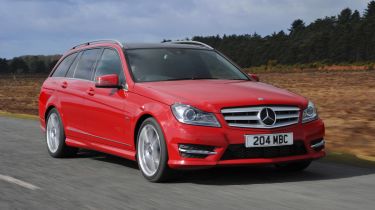Mercedes C-Class Estate (2008-2014) review
The Mercedes C-Class Estate is a practical, desirable and refined family holdall

A major facelift in 2011 has managed to thrust the Mercedes C-Class back to the top of the compact executive sector. For many buyers it’s the practical estate version that makes the most sense, as it continues the brand’s tradition for building versatile and spacious family wagons. Buyers get to pick from a wide-range of petrol and diesel engines, while high performance fans can opt for the tyre-smoking, V8 powered C63 AMG range-topper. All versions are well-equipped, with air-con, Bluetooth and alloy wheels featuring throughout the range. BlueEFFICIENCY versions promise fuel sipping economy and tax-busting C02 emissions. The C-Class Estate is available in three trim levels - SE, AMG Sport and AMG Sport Plus.
Engines, performance and drive
You don’t necessarily buy a Mercedes estate for driving thrills, but the C-Class is still an assured performer from behind the wheel. The turbocharged 1.8-litre 154bhp C180 and 201bhp C250 petrol engines deliver strong pace, as does the smooth and muscular 261bhp 3.0-litre V6 diesel under the bonnet of the C350 CDI. Yet for most owners the 2.1-litre four-cylinder diesel used in the 134bhp C200 CDI, 168bhp C220 CDI and 201bhp C250CDI has the greatest appeal. It’s gruff when extended, but settles down at a cruise and provides plenty of overtaking pace. The vague standard-fit six-speed manual should be avoided at all costs, meaning you’re better off spending extra on the excellent seven-speed auto. Slick steering and standard adaptive damping give the Mercedes a fine ride and handling balance, although keen drivers will prefer the sharper BMW 3 Series Touring.
MPG, CO2 and Running Costs
If you’re considering the Mercedes as a company car, then it’s best to stick to the BlueEFFICIENCY badged models – and the pick of the crop is the C220 CDI. Equipped with stop-start and a six-speed manual gearbox, it promises 60.1mpg at the pumps and a CO2 figure of 125g/km. What’s more, even the rapid C350 CDI will manage nearly 50mpg and emits only 159g/km. Prices are marginally higher than that of a similarly equipped BMW 3-Series or Audi A4, while our experts predict that the C-Class Estate in all its guises will hold onto more than 40 per cent of its value after three years of motoring. The Mercedes is reasonably well-equipped – all models get two-zone climate control, Bluetooth and an iPod connection – and it should be easy to avoid the potentially expensive options list. However, Mercedes has yet to match the excellent fixed servicing deals offered by BMW.
Interior, design and technology
The external changes to the C-Class have been limited to sleeker headlamps, reprofiled bumpers and some eye-catching LED daytime running lamps. Overall, the estate is a handsome design though, but it lacks the racy appeal of the BMW 3 Series Touring and sleek lines of the Audi A4 Avant. However, the classy C-Class is a more grown-up choice than its rivals, particularly in restrained SE guise. Buyers needing to make more of a visual statement can choose the AMG Sport, which adds a subtle bodykit and gorgeous 18-inch AMG alloy wheels. Cabin quality was improved as part of the facelift, with classier materials and an even more solid finish. Sadly, this improvement fails to distract you from the old-fashioned dashboard.
Practicality, comfort and boot space
In the compact executive sector, the C-Class Estate is one of the most practical. All models get a standard powered tailgate, which glides open gracefully to reveal a well-shaped 485-litre loading bay. Fold the rear bench flat and you’ll have a whopping 1,500 litres of carrying capacity to play with. What’s more, the boot is packed with useful hooks and nets, plus there’s a 12V power socket. Elsewhere, there’s plenty of room for occupants front and rear, although the transmission tunnel eats into the legroom of the passenger sitting in the middle seat. Usefully deep door pockets, a large glovebox and a deep, lidded storage box located between the front seats add to the family credentials of the C-Class.
Reliability and Safety
The C-Class comes overflowing with standard safety features, including seven airbags, electronic stability control and tyre pressure monitoring. Further points are awarded for a driver fatigue sensor that monitors steering inputs and advises you to take a break when you’re tired, while adaptive brake lights flash rapidly to warn other road users that you’re performing an emergency stop. The quality and solidity of Mercedes models is now second to none, so the cars should be as trouble-free as their famously tough ancestors. And if there is a problem, the standard three-year warranty is backed up by the firm’s Mobilo scheme, which delivers breakdown cover for up to 30 years if you continue to have your car serviced at a Mercedes main dealer.









